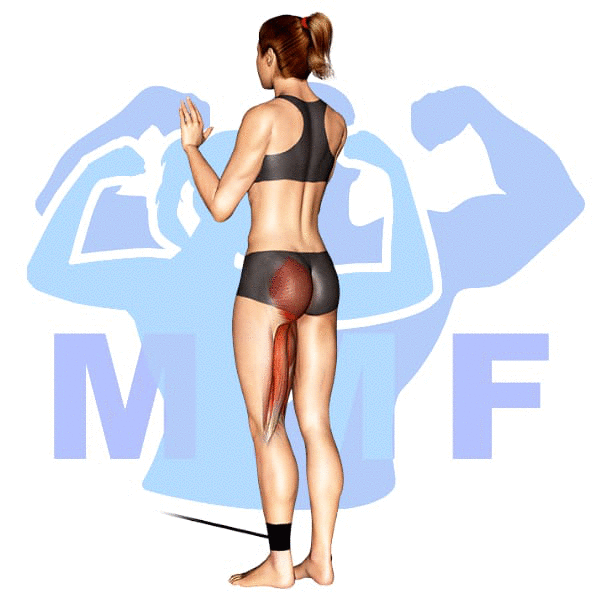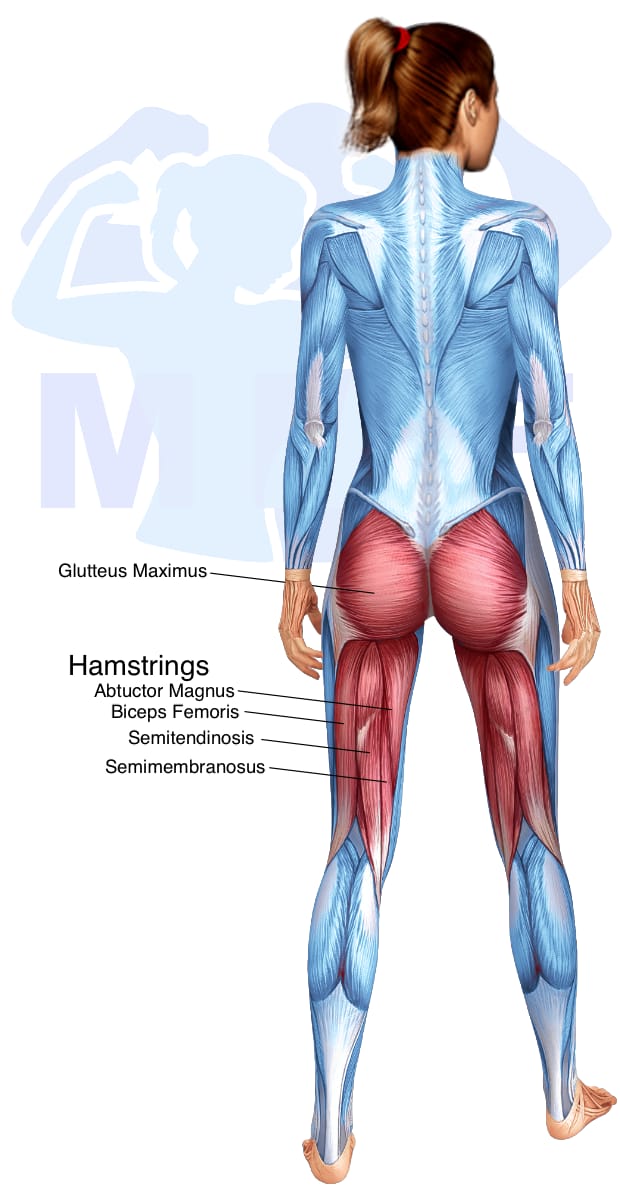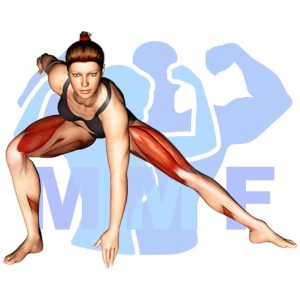Do you struggle with weak glutes and tight hip flexors? Are you constantly searching for a way to strengthen your posterior chain without straining your lower back? Look no further than resistance band single leg hip extensions, an exercise that targets your glutes and hamstrings while simultaneously stretching your hip flexors. Tight hip flexors are a common cause of weak glutes, and sitting for prolonged periods only exacerbates the issue. But fear not, with this simple and effective exercise, you can strengthen your glutes, improve your posture, and alleviate hip flexor pain. Stick around to learn how to perform this exercise correctly and incorporate it into your fitness routine.
Resistance Band Single Leg Hip Extensions Summary
- Primary Muscles: Gluteus Maximus
- Secondary Muscles: Hamstrings
- Equipment: Resistance Band and Door Anchor
- Mechanics Type: Isolation
- Force: Push
- Utility: Auxiliary

Resistance Band Single Leg Hip Extensions Instructions
- Connect each end of the resistance bands to each of your ankles and secure the center of the band to a door anchor around the lower end of the door.
- Next, while facing toward the anchor, step back until the bands are tight.
- After that while continuing to face the door move away until the band is tight while remaining close enough to the wall to brace yourself with your hands.
- Your goal is to be close enough you can lean on the wall or door for brace yourself with your hands. If you can’t get the band tight enough and still touch the wall, try wrapping the band around your other leg until it is tight.
- With your leg extended point your foot towards the bottom of the door.
- Now while only moving at your hip push you leg behind you by contracting your glutes.
- Finally, flex your glutes at the top, then slowly return your leg back to pointing the wall.
- Repeat your hip extensions for 8-12 reps then switch legs.
Video Tutorial
Resistance Band Single Leg Hip Extensions Muscles
Target (Agonist)
Synergists
Dynamic Stabilizers
- None
Stabilizers
- Erector Spinae
- Gluteus Medius
- Gluteus Minimus
- Obliques
- Quadratus Lumborum
Antagonist Stabilizers
- None

Benefits of Resistance Band Single Leg Hip Extensions
Resistance Band Single Leg Hip Extensions are an effective exercise for targeting the Gluteus Maximus muscle. This exercise works by engaging the Gluteus Maximus and other stabilizing muscles, such as the hip flexors and quadriceps, to produce powerful hip extension. This exercise helps to improve strength and stability in the hips and glutes, making it an ideal choice for those looking to improve their lower body strength. Additionally, this exercise requires minimal equipment and can be done at home or in the gym. As a result, it is an accessible and convenient way to add resistance training to any fitness routine.
Tips for Performing Resistance Band Single Leg Hip Extensions
If you want to have the optimum outcomes, adhere to these easy tips. Also, if you desire to reduce the likelihood of injuries, abide by these tips.
- Perform The Appropriate Amount Of Sets With Rest. Your goal at first might be to do 3 sets to near fatigue. However, you can increase to 5 sets. If your muscles aren’t tired at the end of 3 – 5, something should change. Initally, you can increase the resistance to make each rep tougher. Second, you can cut down on the rest time in between your sets.
- Focus On Inhaling And Exhaling. With this and most workouts inhaling and exhaling is very important. You should be exhaling out during the target muscle contraction and inhaling when the primary muscles are expanding.
- Slow Every Repetition Down For Improved Muscle Hypertrophy. When you increase the time under tension you are engaging your muscles longer and they will respond by increasing toned muscles. You can achieve this without raising the resistance by slowing down you reps about 4 – 6 seconds constriction and pause then 4 – 6 seconds extending.
Benefits and Tips Video
Frequent Mistakes To Avoid
You need to refrain from these regular mistakes to manage solid form and reaching your goals. Additionally
- Avoid Cheating. Most of the time, cheating is utilizing momentum as a substitute for the strength of your primary muscle tissue. Sometimes, a bit cheating on your final rep can be fine to overload your muscle, but not for more than a handful of reps.
- Avoid Using Too Little or Too Much Tension. Not enough, and you will not be sufficiently employing your agonist (target) muscle, excess, and you’ll likely need to cheat. Be sure you can complete between 8-12 reps with correct technique.
Find More Resistance Band Exercises Here
Variations and Complementary Exercises
Different variations of the Resistance Band Single Leg Hip Extensions can be used to increase the intensity or challenge of the exercise, as well as provide some variety in your workout routine. Below are some alternative exercises, complementary exercises, and variations of the Resistance Band Single Leg Hip Extensions that can be used to work similar muscles and provide a more comprehensive lower body workout.
Resistance Band Single Leg Bent Over Hip Extensions

The Resistance Band Single Leg Bent Over Hip Extensions is a great complementary or alternative exercise to the Resistance Band Single Leg Hip Extensions. This variation targets the glutes, hamstrings, and lower back in a similar fashion as the hip extension exercise while also engaging the core and obliques to a greater degree. The bent over position allows for a deeper range of motion and activates more muscles, making it a great choice for athletes looking to take their hip extension exercises to the next level. Additionally, the band provides extra tension and resistance to challenge the body even further.
Resistance Band Lunges

Resistance band lunges are a great complementary or alternative exercise to resistance band single leg hip extensions. They work the same muscles, but in a different way, making them perfect for switching up your routine. To do a resistance band lunge, stand with feet hip-width apart and hold one end of the band in each hand. Step one foot forward and lower your body until your front thigh is parallel to the floor and your back knee almost touches the floor. Push off your front foot to return to the starting position and repeat on the other side. This exercise not only strengthens the same muscles used in single leg hip extensions, but it also increases balance and stability.
Resistance Band Kickbacks

Resistance Band Kickbacks are a great complementary or alternative exercise for Resistance Band Single Leg Hip Extensions. They work the same muscle groups and involve similar movements, but with a few differences. While Resistance Band Single Leg Hip Extensions focus primarily on the glutes and hamstrings, Resistance Band Kickbacks target the muscles of the buttocks and inner thighs. Additionally, Resistance Band Single Leg Hip Extensions can be performed with one leg at a time, while Resistance Band Kickbacks require both legs to be in motion. This makes Resistance Band Kickbacks an excellent way to increase intensity and challenge balance.
Check Out These Top Resistance Band Exercises
Resistance Band Deadlifts

Resistance Band Deadlifts are an excellent exercise for strengthening the entire lower body, from the glutes and hamstrings to the quadriceps. They can be done with minimal equipment, making them an accessible and effective exercise for all levels of fitness. Resistance Band Single Leg Hip Extensions are also beneficial for building strength and balance in the lower body, and they can be used as a complementary or alternative exercise to Resistance Band Deadlifts. These exercises target different muscles in the lower body, so they can be used together to achieve a balanced and effective workout.
Stationary Lunges

Stationary Lunges are an excellent complementary or alternative exercise to Resistance Band Single Leg Hip Extensions. They work the same muscle groups, such as the glutes and quads, but with a different emphasis. To perform a stationary lunge, stand tall with your feet hip-width apart and take a big step forward with one leg. Bend both knees until your back knee is almost touching the ground and your front thigh is parallel to the floor. Keep your torso upright and press through your heel to return to the starting position. This exercise can be done in place, or you can step forward and backward for more of a challenge.
Smith Machine Single Leg Deadlift

The Smith Machine Single Leg Deadlift is an excellent complementary or alternative exercise to the Resistance Band Single Leg Hip Extensions. It works the same muscles, with the added benefit of using a weighted barbell to increase the intensity. This exercise requires you to balance on one leg while holding a barbell in your hands. You then lower the barbell down to your toes and lift it back up again. This movement helps to strengthen and tone the glutes, hamstrings, and core muscles. It is also a great way to improve balance and stability, which is essential for any type of athletic performance. The Smith Machine Single Leg Deadlift is an effective exercise for strengthening the lower body and improving overall fitness.
Find More Glutes Exercises Here
Opposing Complementary Exercises
In order to maximize the effectiveness of the Resistance Band Single Leg Hip Extensions, it is important to also include exercises that work the opposite muscle groups. These exercises can help create balance in your workout and prevent any muscle imbalances or weaknesses. Below is a list of exercises that can be used to complement the Resistance Band Single Leg Hip Extensions.
Plyo Split Squats

Plyo Split Squats are a great complementary exercise to Resistance Band Single Leg Hip Extensions, as they target the opposing muscle group. Plyo Split Squats focus on the quadriceps, glutes, and hamstrings, while Resistance Band Single Leg Hip Extensions target the hip flexors, glutes, and hamstrings. The Plyo Split Squats involve jumping from a lunge position and then landing in a split squat position. It is a powerful and explosive movement that increases strength and power in the lower body. It also helps to improve balance, coordination, and agility. By doing both exercises together, you can help strengthen and develop the lower body muscles in a balanced way.
Plyo Side Lunge

The Plyo Side Lunge is a great complementary exercise to Resistance Band Single Leg Hip Extensions as it works the opposing muscle group. This movement helps to strengthen the quads and glutes on the same side of the body, while also improving balance and agility. It involves taking a step to the side with one leg and then jumping up off of that leg, before returning to the starting position and repeating on the other side. This exercise is great for improving coordination and building explosive power in the lower body.
Half Squat

Half Squats are a great exercise to complement the Resistance Band Single Leg Hip Extensions. Half Squats target the quadriceps muscles, which are the opposing muscle group to the glutes that are targeted during the Resistance Band Single Leg Hip Extensions. This makes it a great combination for overall lower body strength and development. Half Squats involve standing with your feet shoulder width apart and lowering your body until your thighs are parallel to the ground. Make sure to keep your back straight and your chest up as you perform this exercise. This exercise should be done in a controlled manner and with proper form to ensure you get the most out of it.
Elevate Your Fitness Routine with Resistance Band Single Leg Hip Extensions!
Ready to take your fitness routine to the next level? Resistance band single leg hip extensions are a great way to strengthen your glutes, hamstrings, and core while also improving your balance and stability. Whether you’re new to resistance training or looking for a new challenge, incorporating these exercises into your routine can help you build a stronger, more resilient body. Plus, with the convenience and portability of resistance bands, you can do these exercises virtually anywhere, anytime – no expensive gym equipment required!
References: Wikipedia | ExRx.net | PubMed.gov | Comprehensive List of Glutes Resistance Band Exercises

